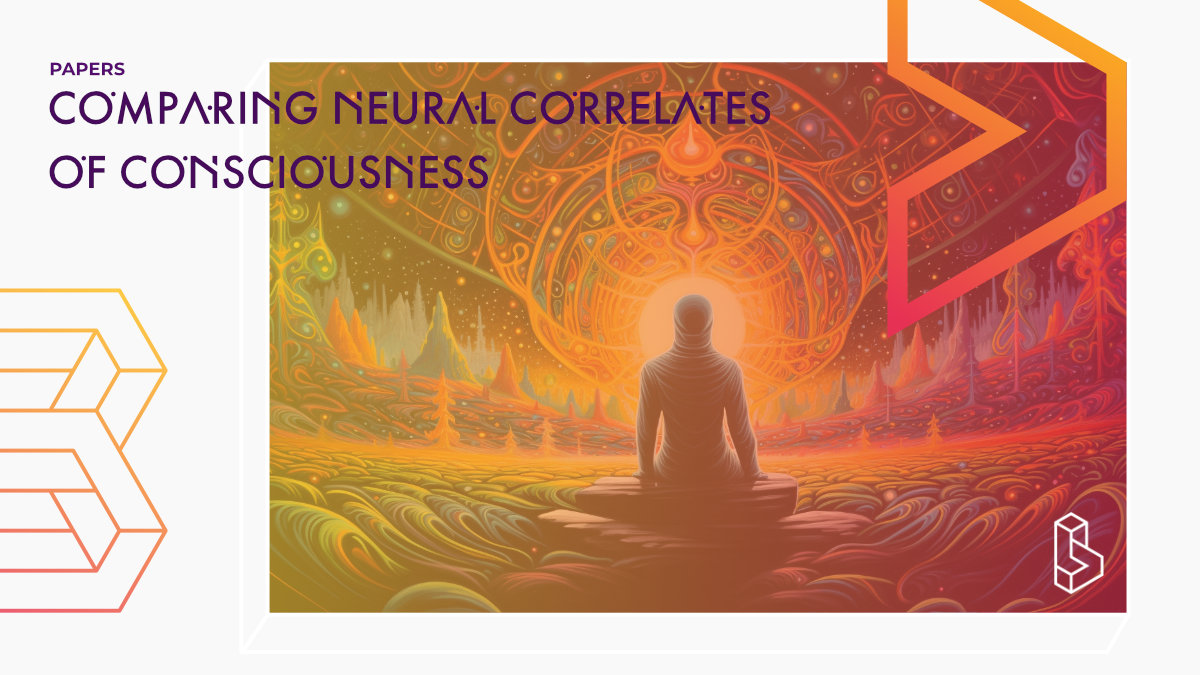This comparative neuroimaging study (n=107) compares the neural correlates of two pharmacological methods, psilocybin (n=23) and LSD (n=25), and two non-pharmacological methods, hypnosis (n=30) and meditation (n=29), in inducing altered states of consciousness (ASC). The results reveal distinct connectivity patterns associated with pharmacological and non-pharmacological interventions, predictability at an individual level, and unique behavioural-neural relationships between psilocybin and LSD, all contributing to a broader understanding of the mechanisms of ASC and their potential therapeutic applications in psychiatric disorders.
Abstract of Comparing neural correlates of consciousness
“Background Pharmacological and non-pharmacological methods of inducing altered states of consciousness (ASC) are becoming increasingly relevant in the treatment of psychiatric disorders. While comparisons between them are often drawn, to date no study has directly compared their neural correlates.
Methods To address this knowledge gap we directly compared two pharmacological methods: psilocybin (n=23, dose=0.2mg/kg p.o.) and LSD (n=25, dose=100μg p.o.) and two non-pharmacological methods: hypnosis (n=30) and meditation (n=29) using resting state functional connectivity magnetic resonance imaging (rs-fcMRI), and assessed the predictive value of the data using a machine learning approach.
Results We found that (i) no network reaches significance in all four ASC methods; (ii) pharmacological and non-pharmacological interventions of inducing ASC show distinct connectivity patterns that are predictive at the individual level; (iii) hypnosis and meditation show differences in functional connectivity when compared directly, and also drive distinct differences when jointly compared to the pharmacological ASC interventions; (iv) psilocybin and LSD show no differences in functional connectivity when directly compared to each other, but do show distinct behavioral-neural relationships.
Conclusion Overall, these results extend our understanding of the mechanisms of action of ASC and highlight the importance of exploring how these effects can be leveraged in the treatment of psychiatric disorders.
Authors: Flora F. Moujaes, Nathalie M. Rieser, Christophe Phillips, Nuno M.P. de Matos, Mike Brügger, Patricia Dürler, Lukasz Smigielski, Philipp Stämpfli, Erich Seifritz, Franz X. Vollenweider, Alan Anticevic & Katrin H. Preller
Summary of Comparing neural correlates of consciousness
The authors directly compare two pharmacological and two non-pharmacological altered states of consciousness interventions in healthy controls to elucidate the common and distinct acute effects of pharmacologically and non-pharmacologically induced altered states of consciousness, and their predictive value for patient stratification.
Psilocybin and LSD are classic hallucinogens that alter perception and experience of the self. Recent neuroimaging studies have revealed that altered information integration in sensory and associative brain regions is important.
Hypnosis and mediation are terms that both incorporate a wide range of mental techniques. In this study, they refer to a specific form of hypnosis termed ‘Esdaile’, and to ‘open awareness’ meditation, which involves the non-judgmental, non-attached observation of salient thoughts and feelings. The authors use four existing datasets to explore the neural correlates of pharmacologically and non-pharmacologically induced ASC, and to assess the predictive value of the rs-fcMRI effects.
Find this paper
Comparing neural correlates of consciousness: from psychedelics to hypnosis and meditation
https://doi.org/10.1016/j.bpsc.2023.07.003
Open Access | Google Scholar | Backup | 🕊
Cite this paper (APA)
Moujaes, F. F., Rieser, N. M., Phillips, C., de Matos, N. M. P., Brügger, M., Dürler, P., Smigielski, L., Stämpfli, P., Seifritz, E., Vollenweider, F. X., Anticevic, A., & Preller, K. H. (2023). Comparing neural correlates of consciousness: from psychedelics to hypnosis and meditation. Biological Psychiatry. https://doi.org/10.1016/j.bpsc.2023.07.003
Study details
Compounds studied
LSD
Psilocybin
Topics studied
Neuroscience
Healthy Subjects
Study characteristics
Original Re-analysis
Double-Blind
Within-Subject
Randomized
Participants
107
Humans
Authors
Authors associated with this publication with profiles on Blossom
Franz VollenweiderFranz X. Vollenweider is one of the pioneering psychedelics researchers, currently at the University of Zurich. He is also the director of the Heffter (sponsored) Research Center Zürich for Consciousness Studies (HRC-ZH).
Institutes
Institutes associated with this publication
University of ZurichWithin the Department of Psychiatry, Psychotherapy and Psychosomatics at the University of Zurich, Dr Mialn Scheidegger is leading team conducting psychedelic research and therapy development.
Compound Details
The psychedelics given at which dose and how many times
LSD 100 μg | 2x Psilocybin 14 mg | 1xLinked Research Papers
Notable research papers that build on or are influenced by this paper
Psilocybin induces time-dependent changes in global functional connectivity: Psi-induced changes in brain connectivityThis double-blind, placebo-controlled fMRI study (n=23) study with psilocybin (14mg/70kg) finds evidence that sensory connectivity increased whilst associative connectivity went down.
Changes in global and thalamic brain connectivity in LSD-induced altered states of consciousness are attributable to the 5-HT2A receptor
This double-blind, randomized, counterbalanced, cross-over study (n=24) investigated the effects of LSD (100 μg) on global brain connectivity during resting-state and observed the synchronization of sensory and somatomotor functional networks and the dis-integration of associative networks.
Linked Clinical Trial
The Role of 5-HT2A Receptor in the Perception of Self and Personal Meaning in Healthy VolunteersAim of the present study is to investigate the neuronal correlates of self and of personal meaning as well as the role of the serotonin (5-HT) 2A receptor system in these processes using functional magnetic resonance imaging (fMRI) and psychometric and cognitive measures.

